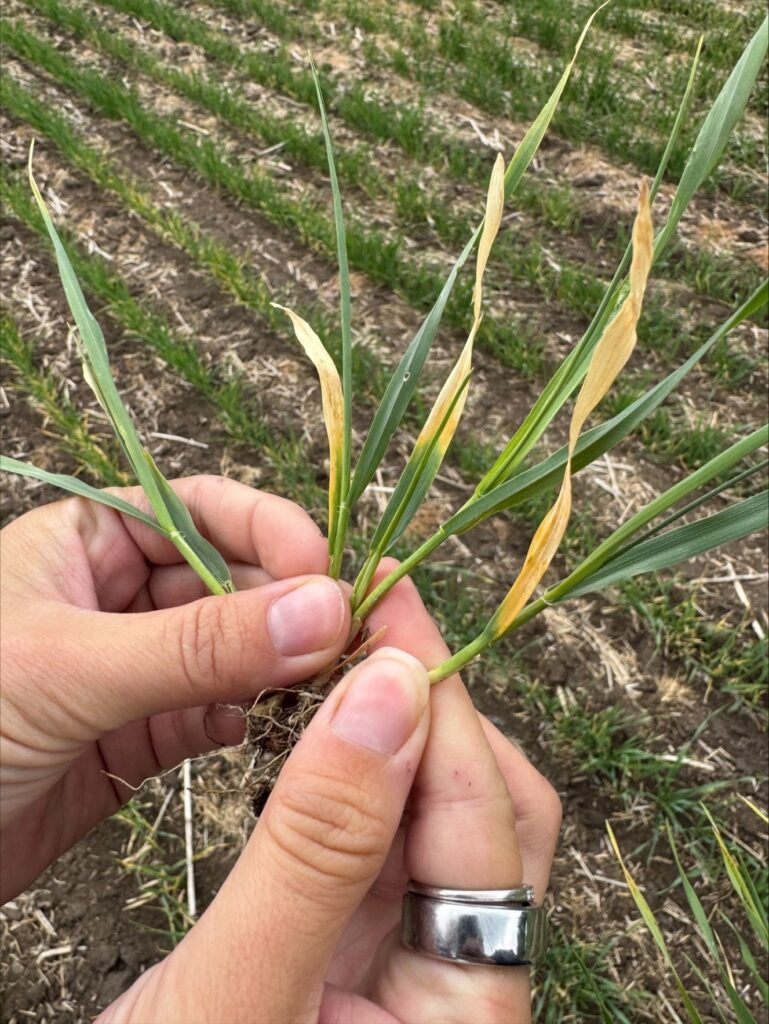Update on confirmation of Barley Yellow Dwarf Virus (BYDV) in two fields in Northwest Saskatchewan, June 2025
Dr. Alireza Akhavan, Saskatchewan Ministry of Agriculture (alireza.akhavan@gov.sk.ca)
Barley Yellow Dwarf is a viral disease caused by Barley Yellow Dwarf Virus (BYDV), a member of the Luteoviridae family. Early infections (before the 4- to 5-leaf stage) may cause severe stunting and failure to head. Infections after the boot stage often show few or no symptoms and typically don’t affect yield. Characteristic symptoms include yellow, red, or purple discolouration of leaves, progressing from tip to base and from margin to midrib. Infected plants may be stunted and scattered among healthy ones.
BYDV infects a wide range of hosts, including barley, wheat, oats, and other grasses. Aphids spread BYDV by feeding on infected plants and then on healthy ones. The virus is not seed- or soil-borne but may occasionally overwinter in perennial grasses and winter cereals like winter wheat. Aphids can then spread the virus to new plants. The spread of BYDV is heavily influenced by aphid migration, particularly from southern regions in the USA. Cool, moist summers and prevailing high-altitude, southern winds favour aphid population growth and virus transmission. Aphids may overwinter as eggs during mild winters, but this is more likely in eastern Canada.
Infections can occur throughout the season, especially when aphid numbers are high. Symptoms usually appear within two weeks at temperatures between 18–21°C. At temperatures above 30°C, symptom expression is often suppressed.
For the two fields with suspected barley yellow dwarf virus (BYDV) symptoms, two sets of separate ELISA tests for BYDV serotypes PAV and MAV were conducted on symptomatic leaves by the Saskatchewan Ministry of Agriculture, Crop Protection Laboratory. The results of the PAV test were positive, while the MAV test was negative. These results support the diagnosis of barley yellow dwarf virus. The barley yellow dwarf virus serotype PAV is the more common serotype.
There is no strong resistance in cereal crops. Effective management includes controlling volunteer cereals (wheat, barley, oats), which can serve as late season hosts for both aphids and the virus. Seeding time may play a role in disease severity. Early seeded winter cereals and late-seeded spring cereals are more vulnerable to aphid infestations.
Symptoms of barley yellow dwarf are diverse and can be similar to nutrient deficiency, root and crown diseases, environmental stresses or other viral infections such as the wheat streak mosaic. A definitive diagnosis needs a laboratory test such as ELISA or PCR. If you would like a sample tested for confirmation of BYDV, submit your samples to the Crop Protection Laboratory in Regina.
Once infected, there are no effective control options. Fungicides are ineffective against viruses such as BYDV. There are no viricides available. Insecticides may be used to control the aphid population, but they may not be effective if prevailing wind patterns bring a new population of infected aphids. Early seeding cereals is the most effective cultural practice to reduce impact from BYDV, because generally early seeded crops have outgrown the most susceptible stages by the time virus infected aphids arrive.
More information
Barley yellow dwarf, The Plant Health Instructor, American Phytopathological Society
Barley Yellow Dwarf Virus, Manitoba Agriculture
Yellow Dwarf of Wheat, Barley and Oats, University of Nebraska
Prairie Crop Disease Monitoring Network, August 2024 in-season update on BYDV in southern Alberta


